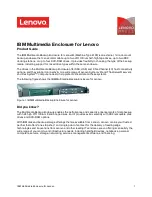
30
1072_0_Product_Manual - February 24, 2011 2:52 PM
Technical
Power Over Ethernet
Power over Ethernet can be used to provide both a network connection and power to a device when a power outlet
is not available. This means that with the proper adapters, you can run the PhidgetSBC entirely off an Ethernet
source. The PhidgetSBC does not draw power directly from a powered Ethernet line, but instead can use a setup
where the power is split to a separate line again near the PhidgetSBC. The board has been tested and will work with
Power Sourcing Equipment that can output 6-12VDC.
Hardware Layout
The PhidgetSBC is based around the SC32440 processor. This is an ARM-920T based microprocessor from Samsung,
which runs at 400MHz. Connected to this is 64 MB of SDRAM, 512 MB of large page NAND and a 10/100baseT
Ethernet controller. The microprocessor brings USB Host port is connected to a 7-port USB 1.1 Hub chip. The
integrated PhidgetInterfaceKit 8/8/8 is connected to one of the hub ports, with the other 6 ports being brought out
to the user.
Software Layout
The PhidgetSBC runs Debian/GNU Linux as its operating system and gets booted with U-Boot. The kernel is 2.6.x
and generally kept up to date with the latest releases. The root filesystem is created using Buildroot and is mounted
in a ~460MB nand partition using the UBIFS filesystem, in Read-Write mode.
Configuration data is located at ‘/etc/webif’. This is where all configuration that can be set through the website is
located.
User applications are stored in ‘/usr/userapps’, each is their own directory.
The kernel is stored on bare Nand in it own 3MiB partition, in the uImage format.
Date and Time
The date and time are set using ntp (network time protocol) at boot. The ntp daemon continues to run in the
background and will periodically update the clock, keeping it very close to real time.
There is a real-time clock with battery backup which will preserve date/time across reboots, power removal. The
real-time clock is synced to system time during reboot/shutdown. If power is unplugged suddenly, the real-time
clock may not have the correct time.
Wireless Networking System
Wireless networking is supported using the available adapter and is configured through the configuration interface.
The back end of the system will be explained here.
Configuration System
The configuration system used by the website is stored in ‘/etc/webif’. These files should generally not be changed
manually, but there is no reason why they could not be. It’s very easy to enter invalid data that could cause the
system to behave unexpectedly or not boot.
















































